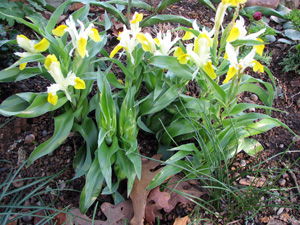Resource Library
Plant of the Week: Iris bucharica
The University of Arkansas System Division of Agriculture does not promote, support or recommend plants featured in "Plant of the Week." Please consult your local Extension office for plants suitable for your region.
Plant of the Week
Iris bucharica

As a gardener I've had lots of failures. The main reason for these phyto-fatalities is that I can't resist trying plants I've never heard of. While most of these trials don't work out and the unknown plant is either ugly or just dies, I have had enough encouragement over the years to keep me hooked on trying new things. One of my recent surprises along this line is a beautiful yellow and white iris growing in my rock garden, Iris bucharica, one of the Juno Irises.
Iris bucharica,named after the Central Asian city of Bukhara, Uzbekistan, just north of the northern border of Afghanistan, is in the Scorpiris section of the large Iris genus. It is a bulbous plant with fleshy roots that persist even during the dormant season and must be protected from accidental disturbance.
In March the bulbs send up shiny green, v-notched leaves arranged alternately on an erect stem that eventually extends 12 to 15 inches tall. The foliage persists until early summer and then dies. At the end of the stem and in each leaf axil is produced a single yellow and white iris flower that is 2.5 inches across. The standards are white, the falls yellow. Plants bloom from the end of the stem down.
This Juno iris was described in 1902 by Sir Michael Foster (1836 – 1907), an English professor of physiology with a passion for irises. He began breeding and collecting irises in the 1880's and was responsible for some of the pioneering work in establishing the boundaries of various hybrid groups. He did not travel to collect plants but had correspondents who sent him plants. The Iris bucharica bulbs he obtained from the UK bulb merchant Van Tubergen who is still in operation. The collection was made in the mountains near Bukhara at between 5,000 and 6,000 feet.
Iris bucharica was my first attempt to grow a Juno Iris, a group of plants iris fanciers often describe as “miffy.” Most of the 60 or so species of Juno irises come from Central Asia where the winters are cold and snowy and the summers hot and dry. Too much rainfall in the summer months and most Junos rot away so dedicated iris growers build little portable shed roofs over their plants to keep them dry in the summer. The name “Juno” is an old genus name for this group of plants which was once separated from the large iris genus.
But with this species, only good soil drainage and hot summertime temperatures are required to prevent the bulbs and fleshy roots from rotting away. Iris bucharica grows on alkaline, gravelly soils so it is probably best to incorporate some limestone chips around the base of the plant before planting the bulbs. I planted mine in the sand bed of my rock garden amended with composted oak leaves. Plants are hardy from zones 3 through 8.
For me it has thrived in light shade under the branches of a single oak tree but most references indicate it is best in full sun. Mine have been in the ground for three years and are multiplying nicely - an indication division will soon be in order. Divide the plants as soon as the foliage dies down in the summer, replanting the bulbs 2 inches deep.
By: Gerald Klingaman, retired
Retired Extension Horticulturist - Ornamentals
Extension News - April 8, 2011
The University of Arkansas System Division of Agriculture does not maintain lists of retail outlets where these plants can be purchased. Please check your local nursery or other retail outlets to ask about the availability of these plants for your growing area.